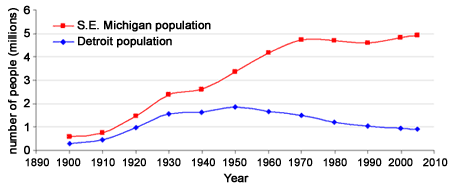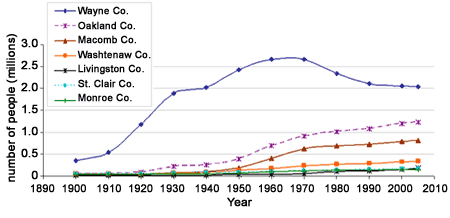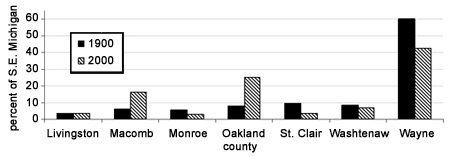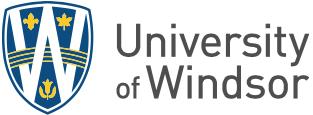Background
During the 19th and first half of the 20th Centuries, immigrants and farmers moved to big cities for the opportunity of higher income jobs in industry. By the middle of the 20th Century, with the greater accessibility of the automobile, big city residents were moving away from urban centers, seeking suburban areas with more space and within driving distances of their work place. Suburbanization and the post-war baby boom generation filled in what are now the inner-ring suburbs. By the end of the century, decentralization of population continued farther from the traditional core cities (SEMCOG 2002).
Southeast Michigan's population growth rate and pattern of expansion has followed a similar pattern experienced in many major metropolitan areas around the country (SEMCOG 2001). All of the counties in southeast Michigan have experienced population increases. Farmland has been bought for subdivisions and woodlots are being cleared for developments throughout southeast Michigan. People who moved farther away from the urban centers to enjoy the rural and suburban life are now finding that the city is moving to them. The places that were once rural are not staying that way, urban areas are continuing to push outward.
Population growth and widespread distribution in southeast Michigan puts pressure on the ecosystem. Uncontrolled growth of urban areas poses serious threat to the natural environment, agricultural and energy resources, and to human health and quality of life. Human population growth and expansion can:
- increase impervious surface and lead to storm water runoff problems;
- decrease wildlife habitat;
- increase water and air pollution;
- increase herbicide and pesticide use; and/or
- introduce non-native invasive species.
Status and Trends
The City of Detroit's population increased more than sixfold during the first half of the 20th Century, due largely to a massive influx of eastern European and southern migrants who came to the area for the burgeoning automobile industry. In 2004, Detroit's population was slightly over 900,000 residents, half the population the city boasted at its peak in the 1950s (Figure 1). Detroit's population decline has been one of the largest in the nation.
In 1900, the total population of southeast Michigan, a region including Livingston, Macomb, Monroe, Oakland, St. Clair, Washtenaw, and Wayne Counties, was nearly 600,000. A century later, in 2000, southeast Michigan's population was just over 4.8 million (SEMCOG 2002). With the exception of a couple of population dips in 1980 and 1990, southeast Michigan has experienced steady growth (Figure 1).

Figure 1. Population growth in Detroit and southeast Michigan from 1900 to 2005 (data collected by Southeast Michigan Council of Governments).
The population distribution has changed substantially in southeastern Michigan between 1900 and 2005. Wayne County's dramatic population growth occurred between 1900 and 1950, while Oakland, Macomb, and Washtenaw Counties experienced steady growth from 1950 to 2005 (Figure 2). This pattern indicates people moving out of Detroit to surrounding areas. Oakland County has experienced the most growth, with just the northern townships increasing 40% since 1990. As of 2005, the fastest growing areas in the region are southern and western Wayne County, the Ann Arbor area in Washtenaw County, much of Livingston County, western and northern Oakland County, and central Macomb County (SEMCOG 2001).

Figure 2. Population fluctuations in southeast Michigan by county, 1900-2005 (data collected by Southeast Michigan Council of Governments).
The region added 4.3 million people between 1900 and 2000. At the beginning of the 20th Century Wayne County was the only urbanized population center. By 2000, Oakland and Macomb Counties had joined Wayne County in becoming urbanized population centers (Figure 3). This reflects the overall shift from agrarian to urban living over the past 100 years (SEMCOG 2002).

Figure 3. Percent of the population of southeast Michigan in each county in 1900 and 2000 (data collected by Southeast Michigan Council of Governments).
The Southeast Michigan Council of Governments estimates that, in the next 25 years, southeast Michigan's population will grow by 10 percent -- but that extra population will consume at least 30 percent more land. Two-thirds of the region's growth will take place in 32 communities in the outer suburbs, converting 250,000 acres from rural to suburban uses (Detroit Free Press 2005).
Management Next Steps
Population growth can lead to dramatic changes in communities and the landscape. As new dwellings, businesses, and industries are built or expanded, land is converted from one use to another to accommodate that change. As development expands across suburbs and once rural landscapes, traffic congestion, unattractive commercial strips, and the destruction of a more pastoral landscape push people who seek open space even farther into the countryside. They are aided by a fast and efficient road network and relatively low land prices.
As people seek the "good life" further and further out from the urban core, land, energy, natural resources, and open space disappear. The land use pattern that results is costly to service and, over time, results in a loss of the very qualities sought by those who moved there. As the transportation system expands into previously undeveloped or minimally developed areas, water and air pollution can increase and wildlife habitat can be fragmented or lost.
The southeast Michigan region and its communities need to utilize growth management techniques that systematically guide the type, rate, location, timing, public cost or, and quality and character of land development in support of growth, yet preserves quality of life. Promising techniques include:
- purchase of development rights;
- transfer of development rights;
- concurrency (pay as you go);
- urban and general services districts;
- development agreements;
- regional impact coordination; and
- interjurisdictional growth management.
Further, special efforts should be expended to integrate land use and transportation planning in southeast Michigan to better manage growth through the regional efforts. This could include:
- reaching agreement on a regional sustainability vision (i.e., economic, societal, and environmental) and signing a partnership agreement to generate cooperation amongst communities and businesses;
- empowering Southeast Michigan Council of Governments to expand its capability to map, inventory, and predict changes in population, land use, and transportation trends (e.g., 2035 Regional Development Forecast; SEMCOG 2001);
- identifying constraint areas from an environmental and servicing perspective in order to indicate where development is and is not appropriate;
- developing regional sustainability policies to preserve key ecosystem features and quality of life (e.g., public transportation, minimizing nonpoint source pollution, stopping floodplain encroachment, limiting impervious surface area development. etc.); and
- proactively working with communities to implement policies and undertaking state of the environment/economy/society reporting every three to five years.
Continued priority should be given to educating the public about the environmental and natural resource consequences of population growth, population density, land use, and transportation practices. Developers and land use and transportation planners need more education on sustainable design.
Research/Monitoring Needs
Southeast Michigan Council of Governments must continue to track population trends and predict future growth and distribution patterns. Also, more research is needed that integrates population trends with land use and transportation planning on a regional scale. Innovative best management practices must be identified that preserve quality of life and sustain our communities, economies, and environments. A combination of incentives and regulatory tools need to be used to better manage growth and ensure sustainability.
References
- Hackney, S. 2005. Red Hot and Rural. Detroit Free Press. (May 2005).
- Southeast Michigan Council of Governments (SEMCOG). October 2001. 2030 Regional Development Forecast for Southeast Michigan: Population, Households, and Jobs, for Cities, Villages, and Townships 1990-2030. pp. 7-9.
- Southeast Michigan Council of Governments (SEMCOG). June 2002. Historic Populations and Employment by Minor Civil Division, Southeast Michigan: Population, 1900-2000; Employment, 1970-2000. pp. 2-5.
Contact Information regarding Human Population Growth and Distribution in Southeast Michigan
Xuan Liu
SEMCOG, Data Center CoordinatorE-mail: liu@semcog.org
Jim Rogers
SEMCOG, Data Center ManagerE-mail: rogers@semcog.org
